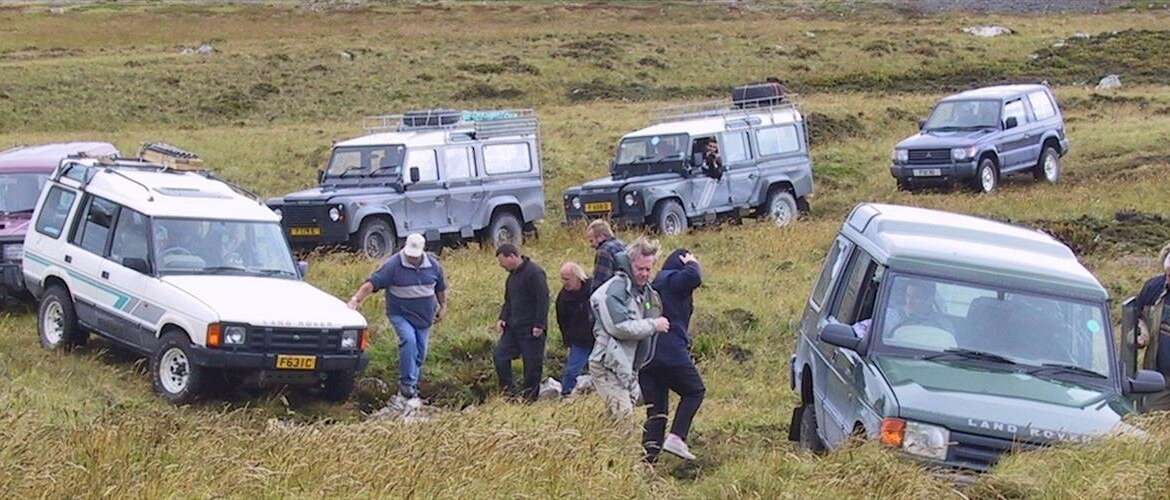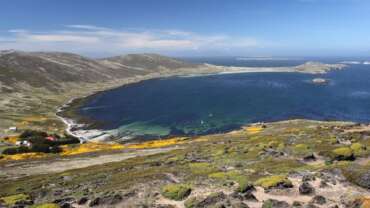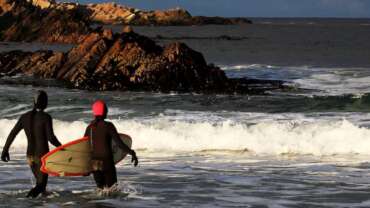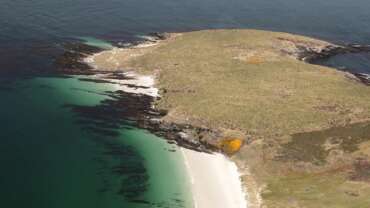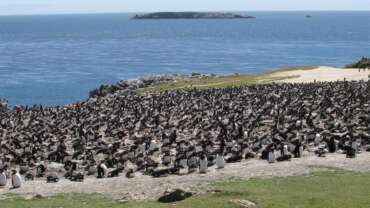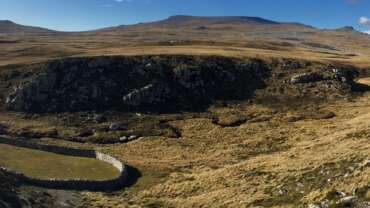Experiences in Falkland Islands
The Falklands archipelago is teeming with wonders of nature and wildlife; an unpolluted environment with fantastically clear blue skies, seamless horizons, vast open spaces and stunning white sand beaches. The Islands are a natural paradise with tiny settlements nestling in many miles of open spaces, fascinating rivers of rock, seas of brilliant aqua greens and silvery blues.
Wildlife up close and personal
Wildlife is free to roam; many species have chosen the Islands as their home. Discover the special feeling when a penguin comes close, stops, takes a good look and then continues on its way. Watch nature in the raw as a whale takes a penguin as prey or marvel at the delicate beauty of endemic flowers.
Unique history
Whilst the wildlife is the major attraction for most visitors, there is also a fascinating history to uncover. Stanley, the Falklands’ capital, is home to the Historic Dockyard Museum, Christ Church Cathedral and an iconic Whalebone Arch. Learn more about our heritage with visits to smaller settlements. Take a tour with a local guide who will be pleased to share stories of times past and present whilst showing you the best of the sights to suit your interest, wildlife, battlefields, beaches ….. as you choose.
Adventure experiences
Travel around the Islands is an adventure in itself, whether by land, sea or air. 4×4 off-roading, boat journeys to tiny islands and flights in the Islander aircraft are all experiences to be savoured.
There are activities to tempt you both outdoors and indoors. Hiking and fishing are popular pastimes. The cool, pristine waters may tempt you in for a paddle or a greater adventure! Try your hand at a local craft or browse Stanley’s shops for that special souvenir. Help out on farms or just watch life go by.
A true escape
Whatever you enjoy, the Islands offer the chance to escape from the everyday stresses and strains of life, simply relax and unwind.
Shopping in the Falklands
A visit to Stanley would not be complete without spending some time in the shops to take home the perfect reminder of your time in the Islands. Gift shops stock many locally made products which are sought after by visitors and residents alike.
Beautiful items are created from the sumptuously soft Falkland wool. Crafted into felted and knitted products, from tiny baby bootees to chunky scarves, eye-catching bags to pretty key-rings, delicately-designed flower brooches to simple soaps, there is a gift to be found for everyone. Unique jewellery pieces are made from Falkland pebbles (a semi-precious, translucent stone) and Falkland coins. Salvaged wood from shipwrecks is up-cycled, the local newspaper has been re-fashioned into purses and fabrics re-purposed in a variety of imaginative ways.
Falkland artists, designers and photographers are continually inspired by their surroundings, producing a whole range of high quality artwork in different media and a range of other goods. Look out for pottery, clocks, clothing, lampshades, placemats, wallets and gift cards all with Falkland themes.
And if you are keen to take a penguin home with you, there are plenty of alternatives to choose from! Soft toys are the obvious choice but of course penguins feature on many souvenir items. Or capture a taste of the Falklands with a jar of diddle-dee jam.
Collectors will enjoy perusing the stamps and coins on offer from the Falklands and South Georgia. Stamps depict many aspects of Falklands’ life past and present, special events, anniversaries and wildlife.
Shopping experiences are not entirely limited to Stanley though it is here you will find by far the largest range of choices. Around the Islands, there are opportunities to pick up that special souvenir, so look carefully at cabinets and wall hangings if you are visiting a guest house or lodge to be sure to not miss out.
Tours & Sightseeing
There is no better way to discover the Islands than with a local guide. Falkland Islanders are keen to share stories, describing life from their perspective whilst showing visitors the very best that their home has to offer.
Overland trips in comfortable 4×4 vehicles or walking tours with an experienced guide provide the perfect way to make the most of your stay, whether visiting for just a day from a cruise ship or for a longer time.
Cruise visitors are able to choose from a variety of Stanley shore excursions including town and nature walks, bus tours, farm visits, trips to wildlife destinations and battlefields. Discover the social and natural history of the Islands, learn about life on a Falklands farm or travel to the memorials of the 1982 conflict. Visits to the smaller islands of the archipelago will include spectacular wildlife colonies and often the experience of a Falklands “smoko” with delicious cakes and cookies that just have to be tasted.
If you are here for a longer stay, you will find many opportunities to tempt you to travel around. Spend a few hours in the company of penguins at Volunteer Point, soaking up the sights, sounds and smells that make this a special place. Visit Bertha’s Beach or Cape Bougainville, Cape Dolphin or Kidney Island to discover many more marine mammals and birds including southern sealions, rockhopper penguins and the delightful Cobb’s wren.
Wildlife tours are plentiful and can be tailored to suit your interests. Similarly trips can be arranged to battlefield sites and memorials, farms, settlements and points of interest. Whether from the Islands’ capital, Stanley, or an accommodation establishment elsewhere, you will find plenty of suggestions to build a personalised itinerary to explore your surroundings with a private guide, as part of small group or as a self-guided activity.
Historic Dockyard Museum
The Historic Dockyard Museum in Stanley contains many exhibits of social and maritime interest as well as displays of natural history and links with the Antarctic. Temporary exhibitions celebrate anniversaries and events happening in the Islands. The museum is a must-see for all visitors, providing an insight into Falklands’ life, past and present.
Traditional Falklands’ life and history
The special lifestyle of the Islands is celebrated through farming tools, children’s bone toys, fretwork, a recreated kitchen with a peat stove, cutlery and crockery including Goss China, various musical items of which the most impressive is a grand mechanical “jukebox” from the late 1800s and much, much more.
Maritime exhibits include models, figureheads, artefacts and relics from sailing vessels. Read quirky stories of mariners and their exploits in the Islands’ waters. Learn also about the modern day fishing industry, the main contributor to the Falklands’ economy.
The world’s oldest remains of the Warrah, a fox-like animal which once inhabited the Islands, form part of the natural history display which includes fascinating skulls and bones from marine mammals. Many of the Falklands’ familiar species are brought to life by taxidermy; an amazingly realistic exhibition of wildlife is set against a backdrop of a recreated seashore. Explore the geological past through rocks, fossils and timelines.
Many visitors want to learn more about the impact of the 1982 war on Islanders and their lifestyles. Listen to audio recordings which tell stories from the perspective of children of those difficult days.
The Falklands are a gateway to Antarctica. The Reclus Hut, a genuine Antarctic refuge, takes you back to the 1950s and to the heart of the explorers’ harsh living conditions as you experience the sounds of the winds and really feel the isolation of the deep south.
New beginnings
The newly opened Dockyard complex is made up of a number of buildings, each with an historical significance. The main museum is housed in an old “storehouse”. The smithy, boathouse and gaol are part of the legacy of the area whilst the R/T station & telephone exchange was moved here from a previous site. These smaller buildings provide additional areas to explore. Look at tools used by blacksmiths, cobblers, carpenters, farmworkers and horsemen. Discover the history of radio and telecommunications to the present day. See early printing equipment used for everything from newspapers and wedding invitations to proclamations of war.
A visit to Cartmell Cottage can also be included as part of your museum entry. This is one of the oldest houses in Stanley and Falklands’ lifestyles of the 1850s, 1940s and 1970s have been carefully recreated.
With so much to take in, set aside at least half a day to make the most of this great attraction.
1982 Battlefields
The war between Britain and Argentina in 1982 is of interest to many visitors to the Falklands. Memorials are placed around the Islands and small museums contain artefacts from both British and Argentine military.
San Carlos
Visit the British military cemetery at San Carlos for a poignant view across San Carlos water where the British troops landed and a fierce battle ensued. Today the atmosphere is notably peaceful and a small corral protects the graves of the few British soldiers buried on the Islands.
Ajax Bay, a disused meat-freezer plant, was utilised as a field hospital and can be visited with permission from the landowner.
Goose Green and Darwin
Around the Goose Green and Darwin area are many significant sites with memorials to British casualties. One hundred and fourteen Falkland Islanders were held prisoner by the Argentines in the community building at Goose Green. The Argentine cemetery at Darwin has a memorial wall partly surrounding simple white crosses, hung with rosaries and flowers, marking out each grave.
Stanley and Fitzroy
Around Stanley are hilltop memorials for the last battles fought before the final surrender. HMS Glamorgan is remembered at Surf Bay and the Atlantic Conveyor alongside the Cape Pembroke Lighthouse. Memorial Wood and the Liberation Monument on Ross Road commemorate the 255 British servicemen who gave their lives. Fitzroy settlement, also on East Falkland, has monuments to the Welsh Guards and seamen who lost their lives from the Sir Galahad and Sir Tristram.
Memorials and memorabilia
Elsewhere in the Islands are other memorials. HMS Sheffield is commemorated on Sea Lion Island. Pebble Island, temporarily requisitioned by the Argentines then recaptured by a daring SAS raid, has memorials including HMS Coventry.
Port Howard museum contains war memorabilia and the remains of crashed aircraft are situated a short drive from the settlement.
Falklands Flora
The Falkland Islands are home to a surprising number of beautiful plants. Around 350 species have been recorded of which 171 are native to the Islands and 13 are endemics which do not occur naturally anywhere else in the world. Introduced plants have arrived both deliberately and accidently. Colourful garden flowers around the Islands are usually imported but there is a growing interest in creating “native species gardens”.
The Falklands’ National Flower
The Pale Maiden is a native species and voted the national flower of the Falklands. This elegant plant has slender stems with bell-shaped flowers, the petals white with distinctive violet stripes. The yellow pale maiden is closely related but much rarer. Both flower mainly in the months of spring and early summer.
Tussac grass is one of the most important plants as it provides a valuable habitat for many creatures, great and small. Tussac grass is found along the coastline and dominates some small islands.
Attractive endemic flowering species include the delicate coastal naussauvia with tiny but prolific white flowers and a sweet smell of nectar on a warm summer’s day; the woolly and smooth daisies with bright yellow flowers; the lady’s slipper, an orange-yellow flower named for its fascinating shape; the snake plant which slides its way through stone runs; the vanilla daisy with beautiful white petals and a very distinctive eponymous scent.
Edible berries
Many native plants can be eaten and offer up a range of tastes. The ubiquitous diddle-dee is renowned for its bitter-sweet red berries; bitter when picked but deliciously sweet when made into jam.
Teaberries are enjoyed picked straight from the plant or baked into buns and pavlovas.
Scurvy grass produces pretty white blooms with a delicate yellow middle and all parts have a lovely citrus flavour, perfect for cordials on a hot summer day. Fachine leaves have a strong “herby” taste.
There is plenty to enjoy – a treat for all senses.
Falklands Life
The essence of the Falklands experience is perhaps that feeling of simply getting away from it all. Life feels almost “in the raw” in many remote locations and an adventure in itself.
The adventure begins by travelling in a twin-propeller Islander aircraft to land on a grass airstrip. Here you board a 4×4 vehicle to be transported to your accommodation. Everything is taken care of by your hosts, who will be on-hand throughout your stay.
Accommodation outside Stanley is farm-based and provides an understanding of how day to day activities are driven by the farming calendar.
Most farms offer the chance to view and some to participate in farm life first-hand. Sheep shearing and sheep herding using dogs happens almost everywhere. Orphaned lambs may need feeding – a treat for a child of any age!
Some farms continue to cut peat for fuel and may be keen for any helper to cut or rickle (build stacks of peat sods to dry). A few farms also keep cattle; some carry out daily milking by hand. If you can get up early enough, you may be invited to have a go!
For many families, home baking and bread making are the norm with a few still making their own butter. Vegetable gardens can be extensive with the produce pickled and preserved at the end of summer. Gardens are great to explore and the tasty products are regularly enjoyed at the table.
Remote locations depend on monthly supplies from the inter-islands shipping service whilst the Government Air Service delivers visitors, post, top-up supplies and gossip that has not yet been communicated by electronic means.Your departure may include responsibility for the mail-bag.
A visit to the Falklands is not complete without a stay on farm to appreciate this aspect of Islands life.



